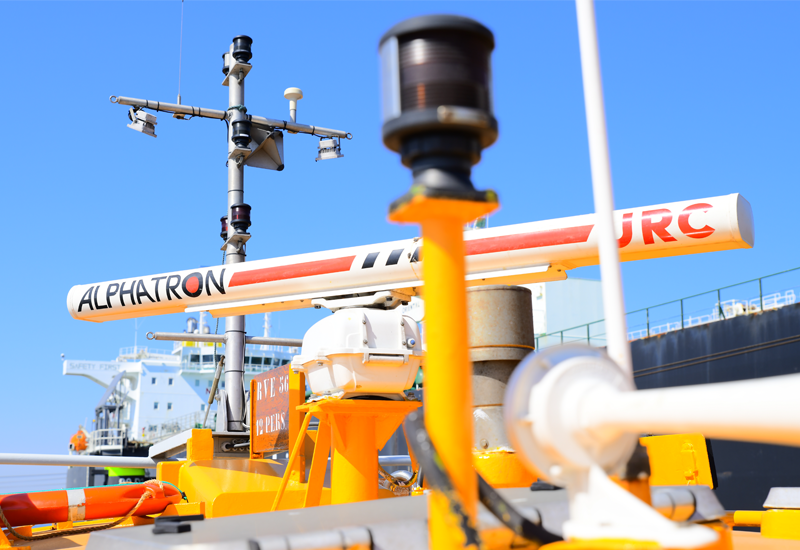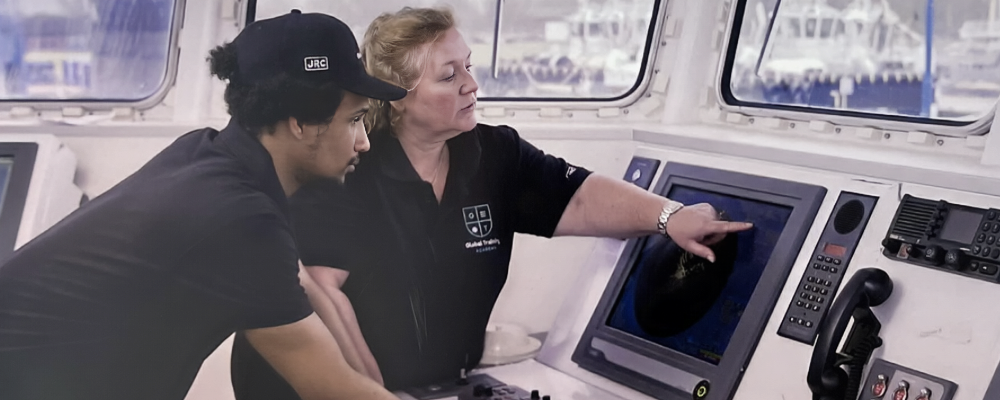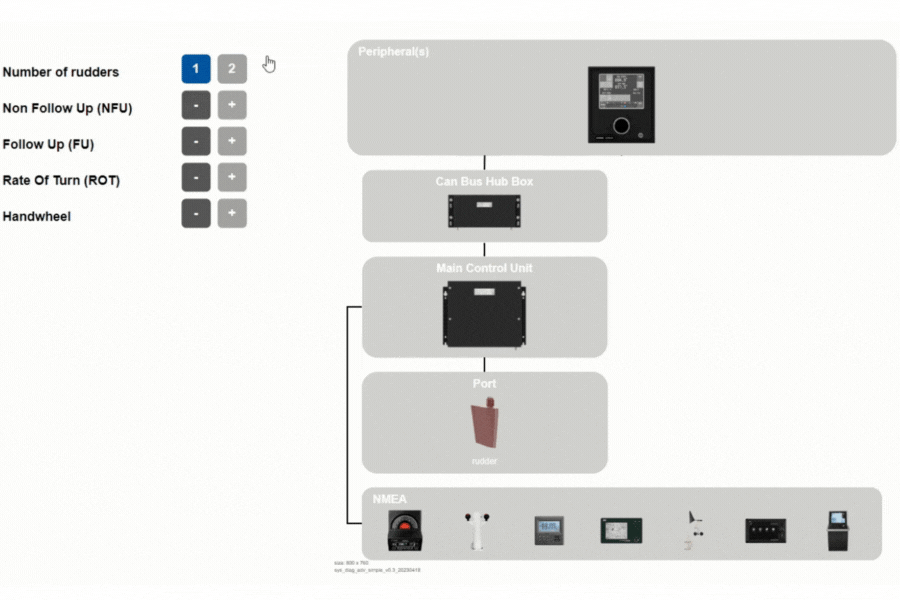JRC | Alphatron Marine

Imagine this: you’re the captain of a huge container ship, standing on your bridge. It’s a beautiful day. The nearest coastline is thousands of miles away and all you see as you stare down the horizon are the endless ocean and an almost entirely blue sky. You’ve done trips like this hundreds of times and as a seasoned captain, you blindly trust the modern navigation equipment of your ship to take you across the ocean without a glitch.
Just as you take a sip from your freshly brewed black coffee and settle into your captain’s chair, you hear people screaming in the distance. The floor starts shaking under your feet and a couple of red lights start to blink on your control panel. In a split second, you’re on high alert. This can’t be right! Did we hit something? What happened?
Alright, alright, that’s enough. You get the point now. The consequences of large ships with failing navigation and communication systems can be immense. Thankfully, modern day ships are packed to the brim with advanced navigation equipment that prevent situations like this from happening almost entirely. And that’s where JRC | Alphatron Marine comes in with their products and their training.

JRC | Alphatron Marine helps people who operate ships. They provide technology for navigation, communication and safety. Their key services and products revolve around control consoles called "integrated bridges" that bring together tools like radar, charts systems and communication equipment to make it easier to see where you're going and talk to other vessels. They also supply navigation equipment such as radars (anti collision), autopilots (automatically steering the ship) and ECDIS (electronic chart system for navigation) to safely sail at sea and dock the ship properly.
Mission critical training
These systems need specialised skills, are mission critical and need to be highly reliable. This makes training the engineers who install the equipment essential for supporting smooth, dependable operations and preventing potential issues down the line. It’s no wonder then that training is a key part of JRC | Alphatron Marine’s activities, making sure that all equipment is developed, class approved, installed, commissioned and serviced to the highest standards.

As an international organisation with hundreds of products and services and a dozen trainers scattered across different geographies, providing consistent and high quality product training is no easy feat. That’s one of the reasons JRC | Alphatron Marine leverages the capabilities of a learning platform like aNewSpring to offer a more consistent and seamless training experience across the globe.
E-learning by product experts
Product training for engineers at JRC | Alphatron Marine consists of an e-learning with the theory and documentation, sometimes followed by a live remote assessment or a hands-on classroom training. Because of the highly technical and specific nature of the training, the trainers are trained at the factory in Japan on the product range.
They are highly skilled and experienced in teaching others to install the products correctly. However, this doesn’t necessarily mean that they also possess the didactic, design and computer skills to translate the technical documentation into an engaging and didactically sound e-learning experience.

Transforming documentation into a learning journey
And that’s why Cindy Makor and Thomas Weghorst decided to team up to take their training to the next level when they saw the chance to do so.
Thomas, being a Mechanical Design Engineer, is responsible for the development of documentation and training for JRC | Alphatron Marine’s AlphaPilot MFM product.
Need for better training material
As the go-to person for knowledge about the installation and commissioning of the product, Thomas kept getting a lot of questions about this. It made him realise that the existing straightforward approach to product documentation and training might not be enough for this new type of advanced equipment. To make sure engineers gain all the knowledge and skills they need to properly and safely install it, he decided to up the game.
Fully leveraging his digital design chops, he started working on a host of additional visual material on top of the regular documentation. The goal was to make the instructions visually more appealing and, above all, more clear and easier to understand. This resulted in enhanced documentation.
But Thomas’s ambition reached further than just better documentation. If he could successfully translate better documentation into a step by step e-learning module in aNewSpring, it would take the training from simple digital documentation to a seamless learning journey.
Design learning to make knowledge stick
So far, Thomas had been on familiar ground. But when he started to put together his own learning journey on the aNewSpring platform, he soon realised that instructional designers are there for a reason. Despite the user-friendly authoring capabilities in the platform, he found himself struggling to determine the best way to guide the learners through the material and make the knowledge actually stick. That’s when he decided to reach out to Cindy with a host of questions.

As JRC | Alphatron Marine’s LMS Officer, Cindy is responsible for equipping all twelve trainers worldwide with the technology and processes to effectively develop their product training. In her role, she had aspired for a while to improve the online part of their training. One of the main goals is to reduce the amount of questions the subject matter experts would get about installing, commissioning and maintaining products. To do so, she was already in conversation with aNewSpring for additional support.
Lack of content
One hurdle so far has been that in order to create a fully fledged learning journey, you need a lot of training material on top of the regular documentation, which isn’t readily available. Also, trainers often don’t have the skills and time to develop all the content needed, let alone to also weave that content together into a full fledged blended learning journey.
When Thomas reached out to her about how he could create a more didactically sound learning journey in aNewSpring and a slew of potential training content, she was eager to team up with him to make his ambition a reality.

A three step training improvement plan
Together with aNewSpring’s Training Improvement Engineer Puck Onnekes, they embarked on a Training Improvement Project. Before they got started, Cindy, Thomas and Puck agreed on a three-phased project plan.
Phase 1: Planning & start
In the first phase, they determined the goals of the project and the desired new structure of the learning platform. Apart from building an improved learning journey for the AlphaPilot training specifically, they agreed that this would need to serve as a blueprint for future learning journeys as well. So, they explicitly set the goal for Puck to document and transfer the didactic knowhow, equipping them to replicate the approach for other training courses. They also created an overall learning design for the training.
Phase 2: Design & build
The second phase was where the real didactic magic happened. First, Cindy, Thomas and Puck dove deeper into the steps towards a more didactic approach to learning content design. They spend multiple one to four hour sessions, answering questions like:
What would be the best way to convey this information?
What is the best learning journey we can realistically achieve?
How to work with the tension between keeping it short, specific and clear and making it attractive, activating and interactive?
Once they got the foundations covered, Thomas worked closely with Puck to create a detailed learning design and a content planning. He then set out to create the content and implemented it into the platform.
Meeting once every one or two weeks, Thomas would get continuous feedback from Puck on his progress, until all the content was ready and implemented. At the same time, Cindy could turn to Puck with any platform questions, to make sure everything was set up correctly on that side..
Phase 3: Transfer
In parallel with the second phase, Puck also started working on documentation to equip Cindy with a didactical blueprint for authors and designers. This was done to make sure the improvement would not end with just one training. They concluded the project with a session where Puck could present the documentation and instruct Cindy how to use it within JRC | Alphatron Marine.

A new benchmark for product training
Thanks to Thomas’s and Cindy’s shared drive to improve and create a better experience for their learners and the support from Puck, the new AlphaPilot training is now the benchmark for product training within JRC | Alphatron Marine. According to Thomas, the first responses from colleagues and learners have been very positive and the first AlphaPilot unit has already been successfully installed on a ship, guided by the new learning journey.
“Their new approach allows them to create more impactful learning journeys that guide their learners to a better understanding of the subject.”
Above all, the project resulted in more didactic awareness and competence at JRC | Alphatron Marine, enabling them to keep improving their training in the years to come. It’s learning pioneers like Thomas and Cindy, who don’t settle for the status quo and are willing to go the extra mile to help their learners learn better, that create true learning impact.
Technology on ships keeps on getting more advanced and interconnected, and thus, more complex to install. Thanks to training improvement initiatives like this captains around the world can rely on skilled engineers to meticulously install and service JRC | Alphatron’s marine equipment, and safely navigate the world's seas.
